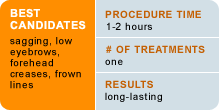Brow Lift (Forehead Lift) – Will It Help You Look Younger?
Medically Reviewed by: Dr. John Kim


Brow lifts are an increasingly popular forehead treatment.
Brow lift is a cosmetic plastic surgery typically used for reducing creases that appear with age in the forehead.
Is a Brow Lift Right for Me?
Most brow lift patients are between the ages of 40 and 70. The best candidates are healthy people seeking a solution to unwanted furrows and deep forehead lines. Other good candidates may include younger people suffering from premature aging signs such as drooping eyebrows. Brow lifts may be used in conjunction with hair transplants to treat a receding hairline or baldness; or with fat transfers to create volume; or with blepharoplasty or facelift to achieve a fully satisfactory outcome.
The Brow Lift Procedure
A forehead lift is performed in an outpatient medical facility, office surgical suite, or hospital. You should discuss the appropriate type of anesthesia with your doctor and the anesthesiologist. A forehead lift usually requires only local anesthesia (awake but sedated), though occasionally general anesthesia (asleep). Time in surgery is about one to two hours, and you return home the same day.
Brow lift may be performed through a conventional-incision method. Alternatively, your surgeon may use an endoscope tool that acts as a visual guide, which requires a smaller incision. The advantages of an endoscopic method can include a smaller incision, no general anesthesia, reduced bruising, quicker recovery time, and less scarring.
Conventional Forehead Lift
Before the procedure, your hair is trimmed and tied back from the area where the incision will be made. The doctor will choose the least visible area to make the incision, such as along your hairline, within the scalp, or along the natural bone structure lines on the scalp.
For a conventional forehead lift, one long incision is made. The incision begins at one ear, cross the forehead region, and ends at the other ear. The forehead skin is lifted, excess tissue is removed, muscles are repositioned or removed, and the eyebrows are lifted. Extra skin in any of these areas will then be trimmed. The incision is stitched or clipped and gauze is applied. A bandage is often wrapped around the head following the procedure. Bandages may be removed within two days of surgery. Stitches and clips are generally removed within two weeks.
After a conventional forehead lift, you may experience
- Temporary discomfort and numbness. This is managed with medication.
- Headache. This can be a side effect from anesthesia
- Swelling. This is managed with head elevation and typically subsides within a week.
- Unusual sensations, which may include itching or lack of sensation at the incision line. This symptom normally disappears within six months.
- Hair Loss. Regrowth usually occurs in one to three months.
Endoscopic Forehead Lift
For an endoscopic forehead lift, several tiny incisions are made within the scalp. The surgeon inserts the endoscopic instrument to produce a visual map of the inside of the forehead and eyebrows. The surgeon then inserts another instrument into the other incisions to lift the skin and to remove excess fat, muscle, or skin on the forehead and eyebrows. Temporary screws or sutures may be fastened to hold the position of the altered skin or muscle. The incision is stitched or clipped and gauzed. After surgery, a bandage is often wrapped around the head. Stitches and staples are removed within a week, and screws are removed in about two weeks.
After an endoscopic forehead lift, you may experience
- Temporary discomfort and numbness. This is managed with medication.
- Swelling. This is managed with head elevation and typically subsides within a few days.
- Unusual sensations, which may include itching or lack of sensation. This is usually a minimal side effect that disappears in a short time.
Brow Lifts: The New Migraine Rx?
Brow lifts may do more than serve a cosmetic purpose. They may also help cure migraine headaches — permanently — according to new research in the August issue of Plastic and Reconstructive Surgery.
In the new study of 75 people suffering migraines that started in the front, side or back of the head, those who underwent a traditional brow lift — the removal of the specific muscle tissue or nerve(s) that triggered their migraines — were more likely to be cured of their headaches than those who underwent “sham” surgery. In the traditional brow-lift group surgeons used fat or muscle to fill in the areas where tissue was removed. The sham surgery merely exposed the nerve, leaving the muscle intact.
Researchers report that 57 percent of those who underwent actual surgery said their migraines went away. Still, some in the sham surgery group reported improvements as well. One year later, 83 percent of the actual surgery group reported at least a 50 percent reduction in migraines, compared to 57 percent of the sham surgery group.
Overall, there was a 92 percent success rate.
Prior to surgery, Botox injections were used to determine if a person was an appropriate candidate for brow lift surgery. After the effect of Botox on the migraine wore off, the recipients were either given real surgery to deactivate their migraine triggers, or a sham procedure. Botox injections work along the same pathways as the surgery. When injected into the muscles of the brow, eyes, forehead, side of the head and back of the head near the neck, Botox can reduce the frequency of both migraine and tension-type headaches for up to six months.
Botox is not FDA-approved for the treatment of headaches, but is often used off-label to do so.
There were some side effects with the surgery, including one instance of persistent numbness of the forehead, and 10 of 19 patients who had the procedure on the side of the head had a slight, but persistent, hollowing in their temples.
Brow Lift Complications and Risks
Complications are rare; however, there are risks associated with any medical procedure. Some patients may not be able to move their eyebrows or forehead. Additional surgery may correct this problem. Scar formation and permanent hair loss within the scar area may occur. Permanent lack of sensation at the incision line is also a rare complication. Infection, bleeding, and other minor complications are possible. According to the American Society for Aesthetic Plastic Surgery, endoscopic patients experience less frequent complications — reporting an incidence of less than 1 percent.
Additional Treatments
Keep in mind that you may need a modified or additional procedure to achieve your goals and expectations. For example, a forehead lift is often performed during a facelift, eyelid surgery, hair transplant, or chemical peel. Your doctor can help develop a successful strategy, which often includes a combination treatment plan customized for each individual.
Consult a Qualified Surgeon
Talk to a qualified doctor about your goals and the treatment options available for your condition.
It’s important to choose a board-certified plastic surgeon from the American Board of Plastic Surgery with extensive experience in all of the facial and forehead-related procedures. Board certification may not always guarantee the best results; however, board certification does require specific and rigorous surgical education and training that improves the odds for a successful outcome.
The type of certification is also important. There are more than 150 self-designated boards, but only a handful that are designated by the American Board of Medical Specialties (ABMS), such as the American Board of Plastic Surgery.
Here are some tips to consider when consulting a plastic surgeon:
- Review doctors’ credentials, education, training, type of certification held and number of times the procedure has been performed in the practice.
- View before-and-after photos of patients who received different types of cosmetic plastic surgical procedures with forehead lifts.
- Bring a photo that helps your surgeon understand what you are looking for. This will help the surgeon understand your expectations and develop a treatment plan.
- Ask about the type of equipment and implant to be used, where the procedure will be performed, and the extent of the procedure.
- Ask about the procedure choice and alternative treatment options.
- Ask about complications and possible side effects of the procedure.
- Review the preoperative and postoperative instructions. These instructions may include
1) no eating or drinking after midnight, the night before surgery
2) a prescribed antibiotic for both before and after the procedure
3) stopping certain medications
4) finding someone to drive you home after the procedure - The recovery period and your activities after surgery should be explained to you as well.
Brow Lift Cost
The extent of the procedure varies among patients, which affects cost. Since the forehead lift may be performed with other procedures, certain costs may be combined, which reduces your overall cost. For example, if you’re having a forehead lift with a facelift, you pay only one anesthesia fee and one facility fee. The total cost can range from $5,000 up to $7,000.
Payments
Some of the cost can be covered by insurance if the procedure is related to a medical necessity (for example, to restore vision due to droopy eyebrows). You can ask your surgeon about filing for insurance. Purely cosmetic procedures are not covered by insurance.
If the cost is too much to pay at once, ask your surgeon about monthly payments.
About the Reviewer
John Kim, MD, is a board-certified plastic surgeon who is Clinical Director of Plastic Surgery at the Northwestern University Feinberg School of Medicine. Dr. Kim has published more than 50 articles and chapters regarding plastic surgery; has had his work featured by ABC News and the Chicago Sun Times, among other; holds several medical device patents; and sits on the editorial board of the Annals of Plastic Surgery, as well as many American Society of Plastic Surgeons committees. www.drkimsurgery.com


